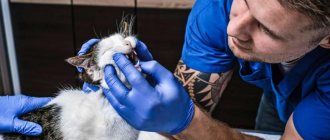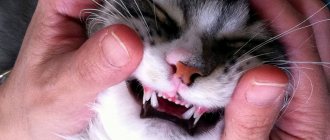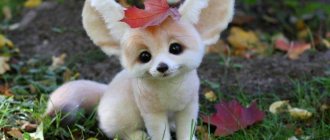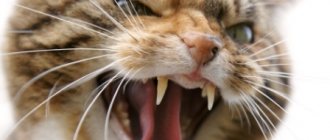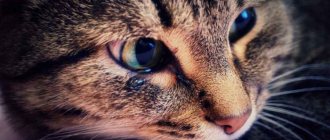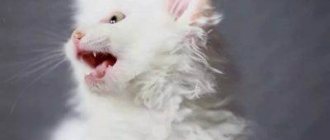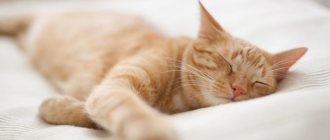Relatives of domestic cats are quite numerous: the existing classification notes the existence of 41 species of representatives of this family. Most of these animals are similar to each other, distinguished by their beauty and noble habits, although some wild relatives of domestic purrs stand out from the general crowd. Large and small cats, among which there are rare and endangered animals, are predators. At the same time, any of the predatory animals on our planet falls into the category of canines or cats. The latter, in addition to large and small cats, include the families of hyenas, civets, mongooses, Asian linsangs, and palm civets.
History of origin and habitat
The first relatives of modern cats formed at the initial stage of the current geological era (Cenozoic). More than 50 million years have passed since then. Scientists say that the familiar appearance of wild representatives of the cat family was formed after the end of the glaciation period. These predators turned out to be one of the lucky few who managed to survive the increase in average annual temperatures. For most other animals with dense, thick fur, the new warm climate of the Earth turned out to be too hot.
The appearance of individual specimens (manul cat) has remained the same since then, other animals have changed greatly in the process of evolution, but have retained the distinctive features of the cat family.
The ancestor of modern predators, miacids, was small in size and had a long tail. In the Oligocene era (about 30 million years ago), these carnivorous animals took a dominant position on the planet.
The extinct predator Proailurus, which most scientists consider the ancestor of small and large cats, spread across the planet 25 million years before the present. This 9-kilogram animal is very similar to the current inhabitant of the island. Madagascar - fossu. About 18.5 million years ago, Proailurus evolved into Pseudelurus. These animals, which first appeared in Eurasia 7 million years ago, entered North America. Of the modern mammals, Pseudalurus most closely resembles African linsangs.
Pseudaelurus was the ancestor of three types of cats: small, large, saber-toothed. Huge saber-toothed mahairods arose 15 million years ago, died out 2 million years ago, leaving no descendants.
Nowadays, predatory relatives of domestic cats are widespread throughout the planet, primarily in warm climate zones. You can’t meet these elegant, flexible hunters only in the snowy expanses of Antarctica and Greenland, Australia and Madagascar. In temperate climates, wild cats are not as widely represented as near the equator or in the tropics. The taiga zone provides shelter only for certain species: lynx, puma, tiger, wild forest cat. But domesticated fluffies amaze with the variety of breeds and are found in all parts of the globe.
The first domestic purrs appeared 7-10 thousand years ago. The cats of Ancient Egypt, deified by man, are well known. Today, many representatives of wild cats have to fight for existence. Modern people have realized the need to preserve the diversity of the Earth's fauna by adopting the necessary international laws to protect flora and fauna.
Varieties
Today, three subspecies of this steppe cat are known:
- Siberian or nominal. It lives in the northern part of its range. Has a gray color.
- Central Asian, who lives in Afghanistan, Turkmenistan, and Northern Iran. Distinguished by red fur.
- Tibetan - with darker fur, black stripes on the tail and body and brighter spots on the head. Lives in Northern India, Northern Pakistan, Tibet, Kyrgyzstan, Uzbekistan.
Characteristic
The cat family (Felidae) includes mammalian predators with common characteristic features: lifestyle, type of nutrition and reproduction, morphology, hunting habits.
Morphology
The sizes of representatives of the cat family range from 30 cm to 4 m, body weight - from 1 kg to 300 kg. Males differ from females in their greater mass, impressive dimensions and additional external features (lion's mane). The largest in the family are lions and tigers, the smallest are black-footed and spotted cats.
Paw structure: 5 toes on the front paws, 4 toes on the hind feet. Sharp claws tend to hide under the paw pads. Cheetahs, as well as Sumatrans, do not possess the latter quality.
Number of teeth: 28-30. This is much less than other known predators. This corresponds to the specific structure of the head: a rounded skull with a short muzzle. With a small number of teeth, effectiveness is achieved by a strong bite. The long, cone-shaped fangs easily tear through the flesh of prey with minimal jaw force. The teeth located behind the cheeks are used to tear pieces of meat from the victim’s body.
The rough tongue is used to lick the remaining meat from the bones of prey and to keep the skin clean.
Long tail, sometimes with a tassel at the end.
The coat is most often short and thick, although differences in density and length are possible depending on the climatic zone of the habitat.
The color palette of the skin varies from brown to gray. Types of colors: plain, spotted, patterned, striped. There are entirely black individuals or (much less often) albinos. The animal's color may change as it grows. For example, lion or puma cubs are covered in spots, while adults have a solid color. The back and outer surface of the limbs are darker than other areas. The animal's muzzle, forehead and tail usually have markings in the form of spots or lines.
Lifestyle
All cats are characterized by excellent functioning of the organs of vision, an expanded range of perception of sounds, up to ultrasonic frequencies. The sense of smell is also good, but in terms of sensitivity it lags slightly behind the two primary indicators.
These animals usually show maximum activity in the dark. Night time is for hunting, day time is for rest.
Lifestyle – solitary or gregarious. At the head of the pack (pride) is a strong aggressive male, who directs the entire life of the community.
A distinctive feature is to make specific sounds (purring). Small cats can purr while inhaling and exhaling, but large cats can only purr while exhaling. Other sounds: roar, hiss, scream, meow. Loud roars are the privilege of large predators. The structure of the hyoid bone does not allow small cats to roar.
Members of the cat family owe their silent movement and the ability to make quick, easy jumps to their toe-based gait.
The process of tracking the victim is simplified thanks to an additional mirror layer on the iris of the eye. This feature allows furry hunters to examine objects at night. In low light, a cat sees 7 times better than a human.
The vertical modification of the pupil provides the predator with a wide view, and the width of the slit is adjusted depending on the light level.
Equipped with muscles, the ears can easily change their geometry, creating a three-dimensional picture of the surrounding world thanks to signals coming from different directions.
Vibrissae, which are commonly called whiskers, are an organ of the “sixth sense” that sends signals to the brain perceived from the environment. Sensors on the paw pads provide information about humidity, atmospheric pressure, and temperature.
An additional olfactory receptor is designed to recognize individuals of the opposite sex.
With rare exceptions, relatives of cats move freely on vertical surfaces and climb to great heights.
The internal etiquette of relationships requires caution and the exchange of signals indicating mood. Unbridled aggression is not the norm of communication.
Like other predators, relatives of cats mark their habitat by secreting a liquid with a specific odor and leaving marks with the help of their claws.
Reproduction
Representatives of cats are distinguished by polygamy. The head of the pack mates with all the females of the pride, so most members of the pack are blood relatives. A wide variety of genes and little competition between males ensure the survival of the young. The season of readiness for mating in females lasts 1-20 days and resumes until fertilization occurs. During the period of estrus, the female calls her partner with special signals and marks the places near the mating area with an odorous liquid.
Competition between male specimens for the attention of a female is expressed in fights, signs of attention, and poses expressing submissiveness (bowed head). The duration of coitus is less than a minute, the act is repeated many times until the girlfriend becomes pregnant. At the end of estrus, the male sets out in search of a new passion.
For animals living in cold zones, the mating season coincides with the warm season.
Small pussies give birth 2-3 times a year, large ones - once every 18 months. Newborn babies are not adapted to independent living and feeding; their visual organs open some time after birth. The mother usually raises the offspring, but for some species nature made an exception and allowed the fathers to also take care of the children. The interval between births depends on several parameters: the rate at which the babies grow up, their size, and the amount of food available in the region where they live. If the litter dies, the female is again ready for mating after 10-20 days.
The number of babies in a litter ranges from 2-4 to 8-10. Small females are ready for pregnancy by the end of the first year of life, carry the cubs for 2 months and keep the offspring breastfed for a month. Large predators learn the joy of motherhood at the age of 3-4 years, carry babies in their wombs for 3 months, and teach their children to solid food 3 months after birth.
Life span is from 10 to 30 years. Minor kittens are exposed to many dangers: death from predatory animals, developmental defects, mother's refusal to feed, cannibalism.
Nutrition
Predatory cats living in the wild feed almost exclusively on meat obtained by hunting. Carrion is rarely of interest to these animals. The diet includes a small amount of herbs to cleanse the stomach of poorly digestible foods. Residents of hot countries add fruit and vegetable desserts to the menu to restore water balance in the body.
Large animals prefer to feed on ungulates, while small animals prefer to eat rodents, birds, and sometimes fish and amphibians.
Unlike cat cubs, other animals are not dangerous to adult predators. Some animals suffer from infection with ecto- and endoparasites (worms, lice, ticks, etc.)
Pampasskaya
This cat is also called the grass cat (Leopardus pajeros), lives in nature in the steppes of South America, is similar in size to its domestic relative, but looks larger. She has long hair (up to 7 cm) of gray, yellow or brown color, black or dark ears, a thick and long tail, and large ears.
Reasons why it is better not to keep her at home:
- The Pampas cat does not allow anyone into its territory.
- Leads a nocturnal lifestyle.
- Little studied.
- Prefers privacy.
- He steals all the birds from his neighbors.
- Doesn't adapt well to domestication.
- Listed in the International Red Book.
- The cost is about 1,000 US dollars.
Genetic classification
Genetic analysis has added new possibilities to the traditional classification based on morphological characteristics, making it possible to rank cats into 8 groups:
- Lions, Tigers and Clouded Leopards, united under the name Panthers.
- A combination of Katopum and Marble cats called Kalimantan cats.
- Caracals.
- Ocelots (8 South American species).
- Lynxes.
- Cougars and Cheetahs under the name Puma.
- Asian species + Pallas's cat are included in the Bengal group.
- Homemade.
The largest wild cat
Liger Hercules Among the wild representatives of the cat family, lions and tigers are considered the largest. These predators can grow up to 250–280 kg. The most impressive size feline known to mankind is the liger Hercules. Ligers are hybrids obtained from lions and tigresses (hybrids - cubs of tigers and lionesses are called tigrolves). Hercules lives in Miami Park. Thanks to its size, the cat was included in the Guinness Book of Records. The weight of this giant is 408 kg.
Tested dental products for cats carry the official seal
Cat owners who want more information about their cat's oral health, as well as advice on what foods are best for their cat's teeth, should visit the Veterinary Oral Health Council website.
“Any product bearing this VOHC seal has undergone rigorous scientific research and meets high standards of effectiveness,” says Dr. Carmichael.
Products range from water supplements to treats and specially formulated kibble, so you can find something that's right for your cat.
Cats can still eat after having their teeth removed
If your cat is diagnosed with dental problems that require removal, don't be discouraged. Cats can eat wet food (and usually even dry food!) without some or even all of their teeth and live long, healthy lives.
“It is more important to have a healthy, pain-free mouth than a mouth full of teeth,” says Dr. Carmichael. Also, if your vet recommends teeth extractions, those teeth are likely painful for your cat, so they will feel much better when they are gone.
Regular dental visits and teeth cleanings will protect your dental health.
Both Dr. Reiter and Dr. Carmichael tout the benefits of daily dental brushing for cats because it prevents the buildup of bacteria that causes many dental problems.
Brushing your cat's teeth may seem like an impossible task, but many cats can be trained with some patience. Dental brushing works best on clean teeth, so start when your cat is a kitten and be consistent between veterinary cleanings.
“In addition, cat owners should always ask for an oral examination during annual visits to the veterinarian,” says Dr. Reiter.

